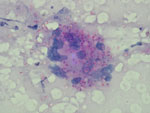Volume 27, Number 3—March 2021
Etymologia
Etymologia: Histoplasma capsulatum
Histoplasma capsulatum [hĭs′tə-plăz′mə kăp′sə-lā′təm]
In 1905, Samuel Taylor Darling serendipitously identified a protozoan-like microorganism in an autopsy specimen while trying to understand malaria, which was prevalent during the construction of the Panama Canal. He named this microorganism Histoplasma capsulatum because it invaded the cytoplasm (plasma) of histiocyte-like cells (Histo) and had a refractive halo mimicking a capsule (capsulatum), a misnomer (Figure).
Histoplasma capsulatum, a dimorphic fungus, now belongs to Kingdom Fungi and causes histoplasmosis (Darling’s disease) through inhalation of spores found in soil and bird droppings. The fungus thrives in the central and eastern parts of United States, especially around the Ohio and Mississippi River valleys, and in South America, Africa, Asia, and Australia. Three varieties exist globally: H. capsulatum var. capsulatum, H. capsulatum var. duboisii, and H. capsulatum var. farciminosum.
References
- Darling ST. A protozoon general infection producing pseudotubercules in the lungs and focal necrosis in the liver, spleen, and lymphnodes. JAMA. 1906;46:1283. DOIGoogle Scholar
- Hagan T. The discovery and naming of histoplasmosis: Samuel Taylor Darling. JAMA. 1903;40:1905–7 http://www.antimicrobe.org/hisphoto/history/Discovery%20of%20Histoplasmosis-Darling.asp cited 2020 Nov 19.
- Histoplasmosis, types of diseases, fungal diseases, CDC [cited 2020 Aug 21]. https://www.cdc.gov/fungal/diseases/histoplasmosis/
- Ramsey TL, Applebaum AA. Histoplasmosis “darling.”. Am J Clin Pathol. 1942;12:85–94. DOIGoogle Scholar
- Slavin MA, Chakrabarti A. Opportunistic fungal infections in the Asia-Pacific region. Med Mycol. 2012;50:18–25. DOIPubMedGoogle Scholar
Figure
Cite This ArticleOriginal Publication Date: February 10, 2021
Related Links
Table of Contents – Volume 27, Number 3—March 2021
| EID Search Options |
|---|
|
|
|
|
|
|

Please use the form below to submit correspondence to the authors or contact them at the following address:
Monika Mahajan, Department of Medical Microbiology, Post Graduate Institute of Medical Education and Research, Research Block A, Sector 12, UT Chandigarh 160012, India
Top